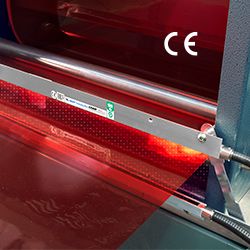When manufacturing CFOs were asked about the top business risks for 2022, 40% highlighted the management of rising inventory costs, 36% of respondents were concerned about managing cash flow and 35% pointed to the management of local and global supply chains.
SYSRPO 2021 Manufacturing CFO 4.0 Report
Q&A with Scott Hebert, CEO | SYSPRO USA
Tell us about yourself and your company SYSPRO?
I’m Scott Hebert, CEO of SYSPRO USA. I was previously chief sales officer and, before joining SYSPRO, I held senior sales roles at Salesforce, Box, Accurate Background and Zadara.
SYSPRO provides an ERP platform purpose-built to meet the unique needs of key manufacturing and distribution industries. Our architecture is future-proofed to easily adapt to new business models and incorporate new technologies, and we’ve got an ecosystem of ISV partners who provide pre-integrated solutions for a wide array of functions, such as artificial intelligence (AI), AP automation and business intelligence. Our team has a deep understanding of the mid-market manufacturer’s business, so we speak their language and can serve as a trusted partner to guide customers through their digital transformation journeys.
The solution is scalable and can be deployed in the cloud, on-premises, or both, and can be accessed via the web on any device to provide customers with choice and flexibility. Since it’s already designed specifically for certain sub-sectors of manufacturing, deployment takes far less time than it would for one of the giant, all-purpose ERP platforms.
We’re a global company that was founded more than four decades ago, and we’ve always been privately held, so we have the ability to focus on the long-term strategic needs of our customers. With more than 15,000 licensed companies in over 60 countries across six continents, we are accelerating digital transformation for the mid-market manufacturer.
Why did you decide to survey CFOs at manufacturing companies?
We did a survey in the second half of 2020 to understand the effects of the pandemic and the associated public health measures on the manufacturing sector, and, unsurprisingly, manufacturers were hurting. Almost half (47%) were unable to function because they were reliant on people working on-premises, and 6 out of 10 were affected by supply chain disruptions.
In late 2021, we wanted to find out how manufacturers’ businesses were doing a year later, what their prognosis was for recovery to pre-pandemic conditions, and how financial leaders were adapting to changing conditions. It seemed to us that one of the most knowledgeable people in the business to ask would be the CFO, since today’s CFOs aren't just financial decision makers. They are also key business navigators, who spearhead innovation and diversification of their businesses.
What were the topline results that manufacturing companies should know as we come out of the pandemic?
In the SYSRPO 2021 Manufacturing CFO 4.0 Report, we found that the majority of CFOs (68%) had either already recovered fully or expected to do so by the end of 2021. Nearly 4 out of 5 (79%) expected to do so by the first half of 2022.
The primary strategy they took to deal with the pandemic was to diversify, with 65% of CFOs saying their organizations did so. And they diversified in various ways: 33% expanded into new markets; 29% introduced a new product line and 39% explored new routes to market, such as e-commerce channels.
But challenges still exist. When manufacturing CFOs were asked about the top business risks for 2022, 40% highlighted the management of rising inventory costs, 36% of respondents were concerned about managing cash flow and 35% pointed to the management of local and global supply chains.
The survey indicates that U.S. recovery from the pandemic varies by industry with mostly positive sentiment. Can you elaborate?
Sure. For the most part, manufacturers were very disciplined about responding to the pandemic. Instead of hunkering down, a significant percentage actually invested in areas that would enable them to take full advantage of the economic recovery when it arrived to grow. For example, 42% expanded operations, 41% invested in new equipment, 33% invested in new technology and 27% invested in R&D. Only 19% limited their spending and investment during the pandemic.
 Given that the vast majority of manufacturers are already back to normal or expect to be there very soon, it seems that this strategy of continued investment worked well, even in the face of continued disruption. It clearly pays to invest in innovation and expansion when times are tough.
Given that the vast majority of manufacturers are already back to normal or expect to be there very soon, it seems that this strategy of continued investment worked well, even in the face of continued disruption. It clearly pays to invest in innovation and expansion when times are tough.
What’s the best advice you can give to manufacturers based on this survey?
Innovation and technological advancement are the keys to thriving in today’s uncertain and fast-moving markets. The pandemic caused manufacturers to accelerate their digital transformation plans. Those organizations that invest in digital technologies and build on a solid foundation of an ERP built for manufacturing, will be well positioned to thrive no matter what comes our way.
The content & opinions in this article are the author’s and do not necessarily represent the views of ManufacturingTomorrow
Comments (0)
This post does not have any comments. Be the first to leave a comment below.
Featured Product

